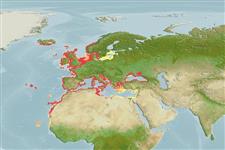Classification / Names
Common names from other countries
Main reference
Size / Weight / Age
Max length : 104 cm TL male/unsexed; (Ref. 113079); common length : 45.0 cm SL male/unsexed; (Ref. 3397); max. published weight: 1.4 kg (Ref. 113079)
Length at first maturity
Lm ? range ? - ? cm
Environment
Marine; brackish; pelagic-oceanic; oceanodromous (Ref. 51243); depth range 0 - ? m
Climate / Range
Temperate, preferred 16°C (Ref. 107945); 65°N - 14°N, 32°W - 42°E
Distribution
Eastern Atlantic and Mediterranean Sea. Three subspecies were recognized by Collette and Parin (1970, Ref. 34977) Belone belone belone (Linnaeus, 1761) (Northeast Atlantic); Belone belone euxini Günther, 1866 (Black Sea and Sea of Azov); Belone belone acus Risso, 1827 (Mediterranean Sea and adjacent parts of Atlantic Ocean, Madeira, Canary Islands, Azores, and south to Cape Verde (Ref. 50279); subspecies Belone belone gracilis Lowe, 1839 (France to the Canary Islands including the Mediterranean) in Collette & Parin, 1990 (Ref. 5757).
Countries | FAO areas | Ecosystems | Occurrences | Introductions
Short description
Dorsal
spines
(total): 0;
Dorsal
soft rays
(total): 16-20;
Anal
soft rays: 19 - 23. Jaw teeth comparatively large and widely spaced. Vertebrae 75-84. Vomerine teeth present at lengths greater than 20 cam. Lower jaw a little longer than upper jaw. Juveniles with greatly elongated jaw, without black posterior dorsal fin lobe.
IUCN Red List Status (Ref. 115185)
Threat to humans
Harmless
Human uses
Fisheries: commercial; gamefish: yes
Tools
Special reports
Download XML
Internet sources
Estimates of some properties based on models
Phylogenetic diversity index
PD50 = 0.6250 many relatives (e.g. carps) 0.5 - 2.0 few relatives (e.g. lungfishes)
Trophic Level
4.2 ±0.4 se; Based on diet studies.
Resilience
Medium, minimum population doubling time 1.4 - 4.4 years (tm=2; Fec=1000)
Vulnerability
Moderate to high vulnerability (49 of 100)
Price category
